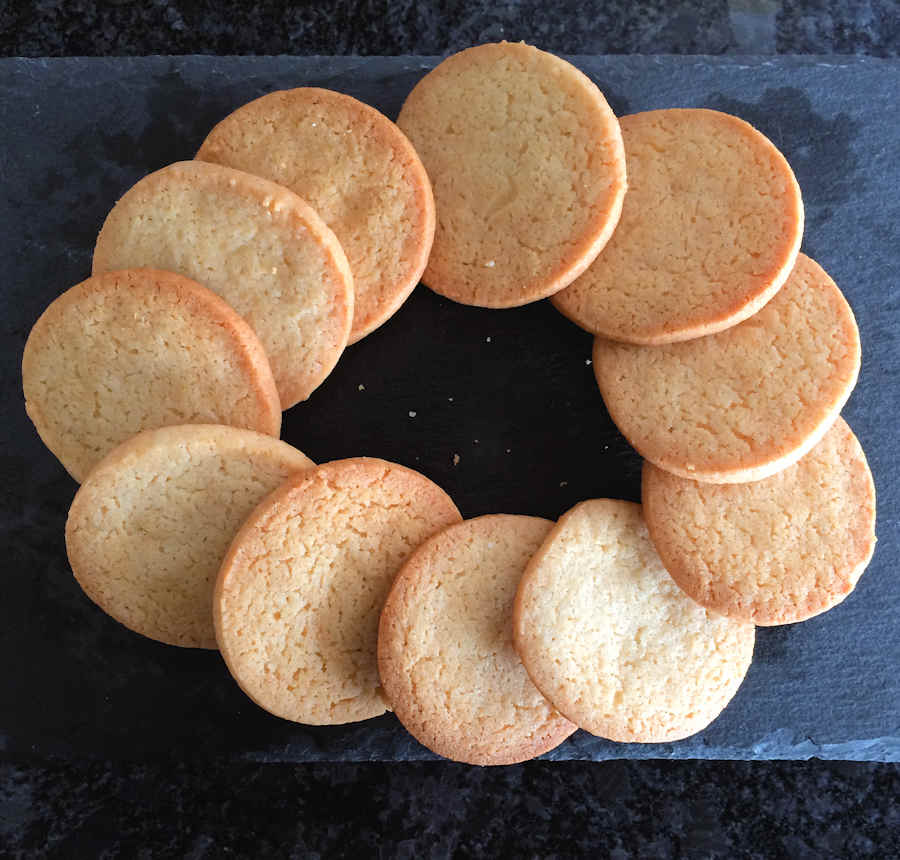Dunk it in your tea or not, everyone likes a biscuit with a crunch, when it melts into sweet and buttery tenderness in your mouth, plain, simple and sublime.

In the last BBC edition of the Great British Bake Off, a few years back, Mary Berry announced that a biscuit must be crunchy.
Must biscuits always be crunchy?
Excuse me: what about cookies? macarons?? lady fingers???
Biscuits are not crunchy by definition, at least not in the wide meaning, and apart from cantuccini they are not normally baked twice.
Jaffa cakes? Digestives? Gingerbreads?
And that’s even before we go over to America and inspect what they call ‘a biscuit’ there. Crunchy it isn’t.
I’m all for a good biscuit (although I don’t dunk), crunchy or not, but let’s not make sweeping generalisations. It’s as if someone said that all steaks must be made with fillet beef.
Crunchy is good
But I don’t make the impression that I belittle crunchiness in general. There's time and place for crunchy, as much as soft in the biscuit world.
Crunchy should not mean hard and tooth-breaking though. Crunchy is perfect when it melts in your mouth and tastes of butter and sugar - which is basically all a crunchy biscuit should be made of.
That taste takes me back to when I was a kid and used to love eating raw crumble mix before it went onto the fruit and into the oven. My Mum would frown and threaten of tummy ache but to this day I believe that uncooked biscuit dough or cake batter is one of the finest things in life.
Plus, as I was happy to discover, some seriously talented bakers share my view that you must sample raw cake batter: if it’s tasty raw, it will bake well.
And a good crunchy biscuit reminds me fondly of that raw flour/sugar/butter combo.
Crunchy biscuits copied from Fox’s crunch creams
I set out to make a replica of Fox’s Crunch Creams which I consider one of the best shop-bought biscuits, without question. Just the biscuit though, as the filling is where shop-bought would beat my buttercream on eat-by date (with lots of E-numbers).
But if you wanted to do the full works, the sandwich biscuits filling is pretty simple: it’s basically just thick icing with added melted butter. Dive here (not just on Valentine's Day) for the filling recipe.
How to make a copy of Fox’s Creams?
By trial and error they came about. I made the first batch with the addition of some egg as the dough wouldn’t come together but it was wrong. The resulting biscuits had not enough crunch, not enough melt.
The second time round I only added a bit of lemon juice to help the dough gel - and the result was spot on.
Because the truth is as said above: good biscuits are a combination of sugar, butter and flour in perfect proportions.
Do biscuit dough need to chill?
It depends how you want to handle it. The simplest way is to shape a long dough sausage and slice it into rounds. For that it needs to be chilled, otherwise you’ll end up with squashed shapeless cookies instead of perfect discs.
But if you fancy cutting shapes, roll out the dough straight after it’s made. Cut your shapes, arrange them on the baking trays and only then chill them while the oven is heating up. What’s important is that they go into the oven cold – that’s the guarantee of the crunch and the ‘short’ texture.
Biscuits for desserts
There is nothing lovelier (or more British) than a biscuit alongside your cup of tea or coffee, and these play the part perfectly. But you can use them in various puddings, trifle first and foremost, which is not my favourite hence I don’t even have a recipe for it.
Crumble a biscuit over vanilla ice cream or serve two or three with chocolate mousse, panna cotta or lemon posset.
Sandwich them with lemon curd for a quick treat, or with any leftover buttercream that you prudently stored in the freezer for such an occasion.
More British biscuit recipes
Classic shortbread is the ultimate crunchy biscuit, surely. Good shortbread has a melting crunch; a bad one explodes into dry crumbs.
Another classic: ginger snaps. They are never gingery enough in my experience!
And the most easily recognisable: milk chocolate digestives. Yes, you can make them at home.
More biscuit recipes from all over the world
Crunchy biscuits from across the Atlantic are called sugar cookies: like snickerdoodles for instance.
And in France they are called ‘sablé’ – sand biscuits. Here with cocoa nibs and a chocolate drizzle.
The Italian version is truly crunchy: no wonder, as they are baked twice, in the true meaning of the word ‘biscotti’.